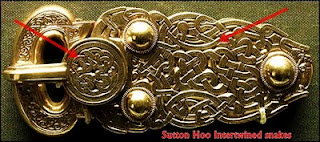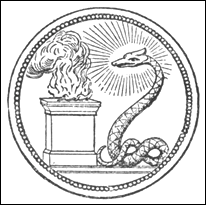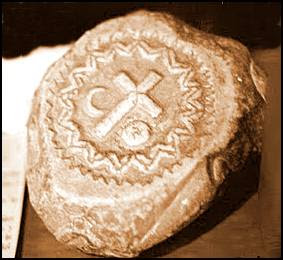Strange snakes of alleged Celtic or Phoenician origin found engraved on Patagonian rockss. Native or Semitic - Celtic art?
See Index on all my posts on Phoenicians in America.
Alleged Tehuelche engraved stone with several intertwined snakes. Source: Internet
Above, is an image of an engraved stone, found in Chubut, Patagonia, which is attributed either to Phoenicians navigators who somehow reached the region or to Celtic mariners who somehow strayed and landed in Patagoina, or, an imitation crafted by local Tehuelche natives, who based their art on originals that the new arrivals (either Celts or Phoenicians) showed them.
Far fetched? Yes indeed. But, the stones exist, and they are either fakes, made in recent times (we will look into this option in a future post), or authentic stone carvings, crafted by some “ancient” people who lived in Chubut, Argentina.
Writhing Celtic snakes
The “Celtic” link is due to the fact that “Celts” represented intertwined snakes in their art. And, this is indeed so, as can be seen in the following examples.
The oldest is from Sutton Hoo, a village in East Anglia, England. Where an Anglo-Saxon king was buried around 625 AD. His burial included several gold jewels, among which is his buckle, shown below:
"Celtic" Buckle with intertwined snakes. Sutton Hoo, England. ca 625 AD. Souce: Internet
Another example is the beautiful cover of the Lindau Gospels (St. Galle Abbey, Switzerland. Circa 875 AD), which depicts snake or lizard-like creatures, intertwined, interlaced; which is shown below:
Lindau Gospel, ca. 875 AD. Intertwined snakes. Source: Internet
Both are beautiful examples of Germanic snakes (in my opinion they are not Celtic).
The "real" Celt examples found on the Internet are usually Irish crosses or symbols related to them. These are interesting images with intricate designs fashioned from knotted ribbons, but I have not been able to find one ribbon that resembles a snake. The Celts and their druid priests worshiped the snake (as a kind of phallic symbol), and they drew on their banners a snake intertwined around a wooden staff.[2] And this, in an island withoug snakes! (the myth surely came from the Celtic homeland in Europe or beyond).
However, none of these images resembles the writhing Patagonian snakes shown in the image that begins this post.
We will have to look at the Phoenician snakes to see if they can offer some clues.
Phoenician snakes (with a touch of Greece and Egypt)
In the ancient Middle East, in Babylon, two intertwined snakes were the symbolic representation of healing, wisdom, and fertility. From its place of origin in Mesopotamia, it migrated west, reaching the Mediterranean, where it was adopted by the Phoenicians. It is depicted in the image below, of the Phoenician Deified Serpent, or Serpent of Fire. [1]:
Phoenician serpent of fire. From [1]
In turn, besides adopting the Phoenician alphabet, The Greeks also took this god from the Phoenician pantheon, as their own god Asclepius or Asklepios.
He was symbolized by a wooden staff with a serpent wrapped around it. And that symbol originated from a Phoenician god, that had an ophidian origin:
"the word apah or epah, (frequently written apa or epa or epe in the Talmud) signifies a viper, a basilisk, a serpent. This word may have been often conjoined with that of Escul". [3]
Then there is also the symbol of the Caduceus which is a wand with two (not one –as was the case of Asclepius), belonging to Hermes, another Greek God. Which is no other than the Roman god Mercury, the god of trade and commerce. [4]
The serpent god is a very ancient myth, and the Phoenician one also has links to its Egyptian counterpart, Thoth:
The Egyptian god Seth, whose name, in Egyptian (and in Hebrew) means, “pillar”, that is, erect, tall, high is a phallic god. Interestingly, the Egyptian Book of the Dead also calls Seth, “Tet” , which is one of the names of the Egyptian god “Thoth”. Furthermore, Tet was the Phoenician god “Taaut, which is the one who originated the ophidian Esculapius.[5]
This "Taaut", according to Eusebius [*] also invented the alphabet!:
Taautus was the first who thought of the invention of letters, and began the writing of records: and he laid the foundation, as it were, of his history, by beginning with him, whom the Egyptians called Thoyth, and the Alexandrians Thoth, translated by the Greeks into Hermes. [7]
[*] The Bishop, Eusebius of Caesarea, (c. AD 263–339), quoted extensively from a previous historian, Philo of Byblos (c. AD 64-141), using material from Philo's Phoenician History.
So, as we can see, Thoth, Tet, Taaut and Esculapius are all the same god.
Regarding this “Egyptian” connection, intertwined snakes also appear in predynastic times in Ancient Egypt. [6] as can be seen in the following images dated to about 3.200 BC:
Predynastic Egyptian intertwined snakes ca. 3200 BC. From [6]
These snakes look more like the Patagonian one, being undulated and rounded, however they are not knotted into a circular mat, instead, they are "parallel" to each other.
Anyway, there is a link between Phoenicia and snakes, so if (a big if) the Patagonian engraved stones are authentic and not the work of some forger, then, they could have a Phoenician origin.
Sources.
[1] From Phoenician Coin. Maurice’s Indian Antiquities, Vol. VI, p. 368. London, 1796.
[2] James Bonwick, (1894). Irish Druids And Old Irish Religions. Forgotten Books. pp 144.
[3] Sir. William Drummond, (1826). Origines: Or, Remarks on the Origin of Several Empires, States and Cities. Baldwin and Co. Vol. 3. Phoenicia, Arabia. pp. 223.
[4] Keith Blayney , (2002). The Caduceus vs the Staff of Asclepius (Asklepian).
[5] Staniland Wake, (1870). Influence of the phallic idea in the religions of Antiquity. Chapter: The Hebrew Identified With Ethnic Religions.
[6] Archae Solenhofen , (2003). The tomb of Sabu and the tri-lobed "schist" bowl. August 25, 2003.
[7] Canaanite Resources. Eusebius of Caesarea: Book 1 - Chapter X. From Eusebius of Caesarea: Praeparatio Evangelica From Book 1. Chapters 9 and 10.
Patagonian Monsters - Cryptozoology, Myths & legends in Patagonia2011 International Year of Forests Copyright 2009-2011 by Austin Whittall ©










































